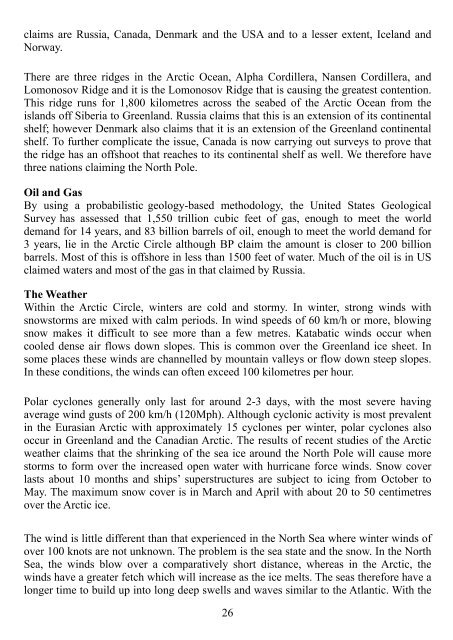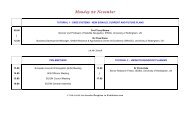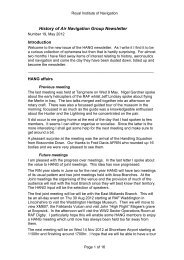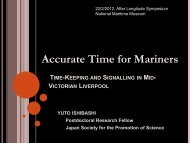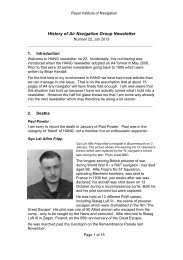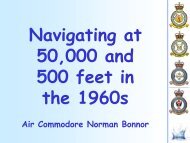Fairway 30 - Royal Institute of Navigation
Fairway 30 - Royal Institute of Navigation
Fairway 30 - Royal Institute of Navigation
You also want an ePaper? Increase the reach of your titles
YUMPU automatically turns print PDFs into web optimized ePapers that Google loves.
claims are Russia, Canada, Denmark and the USA and to a lesser extent, Iceland and<br />
Norway.<br />
There are three ridges in the Arctic Ocean, Alpha Cordillera, Nansen Cordillera, and<br />
Lomonosov Ridge and it is the Lomonosov Ridge that is causing the greatest contention.<br />
This ridge runs for 1,800 kilometres across the seabed <strong>of</strong> the Arctic Ocean from the<br />
islands <strong>of</strong>f Siberia to Greenland. Russia claims that this is an extension <strong>of</strong> its continental<br />
shelf; however Denmark also claims that it is an extension <strong>of</strong> the Greenland continental<br />
shelf. To further complicate the issue, Canada is now carrying out surveys to prove that<br />
the ridge has an <strong>of</strong>fshoot that reaches to its continental shelf as well. We therefore have<br />
three nations claiming the North Pole.<br />
Oil and Gas<br />
By using a probabilistic geology-based methodology, the United States Geological<br />
Survey has assessed that 1,550 trillion cubic feet <strong>of</strong> gas, enough to meet the world<br />
demand for 14 years, and 83 billion barrels <strong>of</strong> oil, enough to meet the world demand for<br />
3 years, lie in the Arctic Circle although BP claim the amount is closer to 200 billion<br />
barrels. Most <strong>of</strong> this is <strong>of</strong>fshore in less than 1500 feet <strong>of</strong> water. Much <strong>of</strong> the oil is in US<br />
claimed waters and most <strong>of</strong> the gas in that claimed by Russia.<br />
The Weather<br />
Within the Arctic Circle, winters are cold and stormy. In winter, strong winds with<br />
snowstorms are mixed with calm periods. In wind speeds <strong>of</strong> 60 km/h or more, blowing<br />
snow makes it difficult to see more than a few metres. Katabatic winds occur when<br />
cooled dense air flows down slopes. This is common over the Greenland ice sheet. In<br />
some places these winds are channelled by mountain valleys or flow down steep slopes.<br />
In these conditions, the winds can <strong>of</strong>ten exceed 100 kilometres per hour.<br />
Polar cyclones generally only last for around 2-3 days, with the most severe having<br />
average wind gusts <strong>of</strong> 200 km/h (120Mph). Although cyclonic activity is most prevalent<br />
in the Eurasian Arctic with approximately 15 cyclones per winter, polar cyclones also<br />
occur in Greenland and the Canadian Arctic. The results <strong>of</strong> recent studies <strong>of</strong> the Arctic<br />
weather claims that the shrinking <strong>of</strong> the sea ice around the North Pole will cause more<br />
storms to form over the increased open water with hurricane force winds. Snow cover<br />
lasts about 10 months and ships’ superstructures are subject to icing from October to<br />
May. The maximum snow cover is in March and April with about 20 to 50 centimetres<br />
over the Arctic ice.<br />
The wind is little different than that experienced in the North Sea where winter winds <strong>of</strong><br />
over 100 knots are not unknown. The problem is the sea state and the snow. In the North<br />
Sea, the winds blow over a comparatively short distance, whereas in the Arctic, the<br />
winds have a greater fetch which will increase as the ice melts. The seas therefore have a<br />
longer time to build up into long deep swells and waves similar to the Atlantic. With the<br />
26


